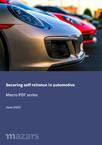Securing self reliance in automotive
As per IBEF, total passenger vehicle sales touched ~2.7 million in FY21, while ~1.61 million units were sold in FY22. The industry is poised to reach USD 300 billion by 2026.
While India's automotive industry has encountered numerous hurdles in recent years, including the disastrous COVID-19 pandemic, its development potential is undeniable. The industry has showed resiliency, with both sales and valuations rising. Customer demand is expanding, and innovation is continuing at a rapid rate. Investment in additional capacity, particularly for electric vehicles (EVs), is skyrocketing.
The notion of self-reliance has gotten much acclaim post covid-induced lessons, as both the government and industry players look toward spurring up domestic auto production and manufacturing, including the move toward semiconductor independency. India is envisaged to become a manufacturing powerhouse and a global supply center nerve, with automotive serving as a critical leg.
This macro-PDF series studies the opportunity brought about by undertaking self reliance in automotive from a People, Development and Financial angle.

